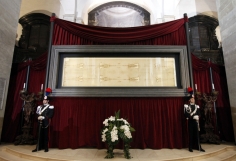
Not much is known about Jesus as a young boy, but Italian police have created a digital image of what they claim he would have looked like.
Using the Shroud of Turin, a cloth believed by millions to have been wrapped around Jesus after the crucifixion, detectives in Rome generated a photo-fit image of the face imprinted on the material. They then digitally reversed the ageing process to create a young boy, without the beard and with a softer face – and, perhaps most unusually, with blond hair.
The image was created for an upcoming television show in Italy, but also to mark the exhibition of the Shroud at Turin Cathedral. The relic is expected to draw a crowd of two million, including the Pope, who is scheduled to visit on June 21.
According to the Christian Times, the host of the TV special, Elena Guarnieri, said the idea to create an image of young Jesus came to her team as an "illumination, maybe it was inspiration."
"If that is the face on the Shroud, then this is the face of Jesus as a child," she said.
However, the authenticity of the relic remains under question, and many researchers and scientists have branded it a fake.
In an article for the History Today journal last October, British scholar Charles Freeman claimed that the Shroud was probably nothing more than a prop used in a medieval ceremony that took place early on Easter Sunday; the Quem Querritis, 'Whom do you seek?'

"One of the most important features of the ceremony was the display of the cloth," Freeman said. During various performances, it is thought that it would have been used in depictions of the empty tomb after Jesus has risen.
"No one has found any significant evidence of the Shroud's existence before 1355, when it appeared in a chapel at Lirey, in the diocese of Troyes, supposedly advertised there as the burial shroud of Christ," Freeman added.
Scientists carbon-dated the Shroud in 1998 and estimated that the image was made in the 13<sup>th or 14<sup>th centuries. However, Researchers at the Politecnico di Torino claimed in 2014 that a powerful earthquake in Jerusalem in AD 33 could have skewed radiocarbon dating results and made the cloth seem younger than it truly is.
In 2011, another group of Italian scientists, this time from the National Agency for New Technologies, Energy and Sustainable Development, claimed that the relic could not have been forged using technologies available in medieval times.














